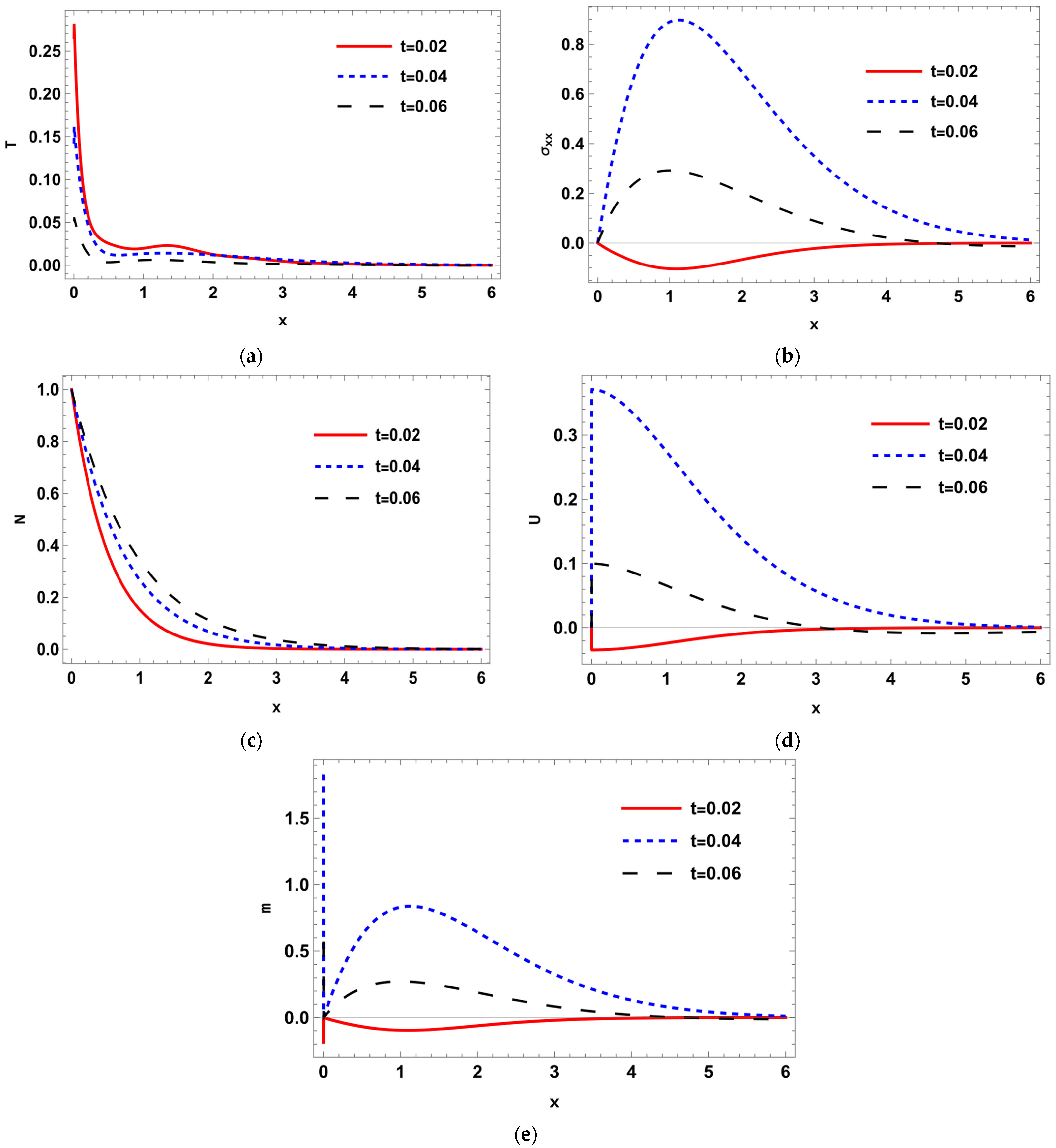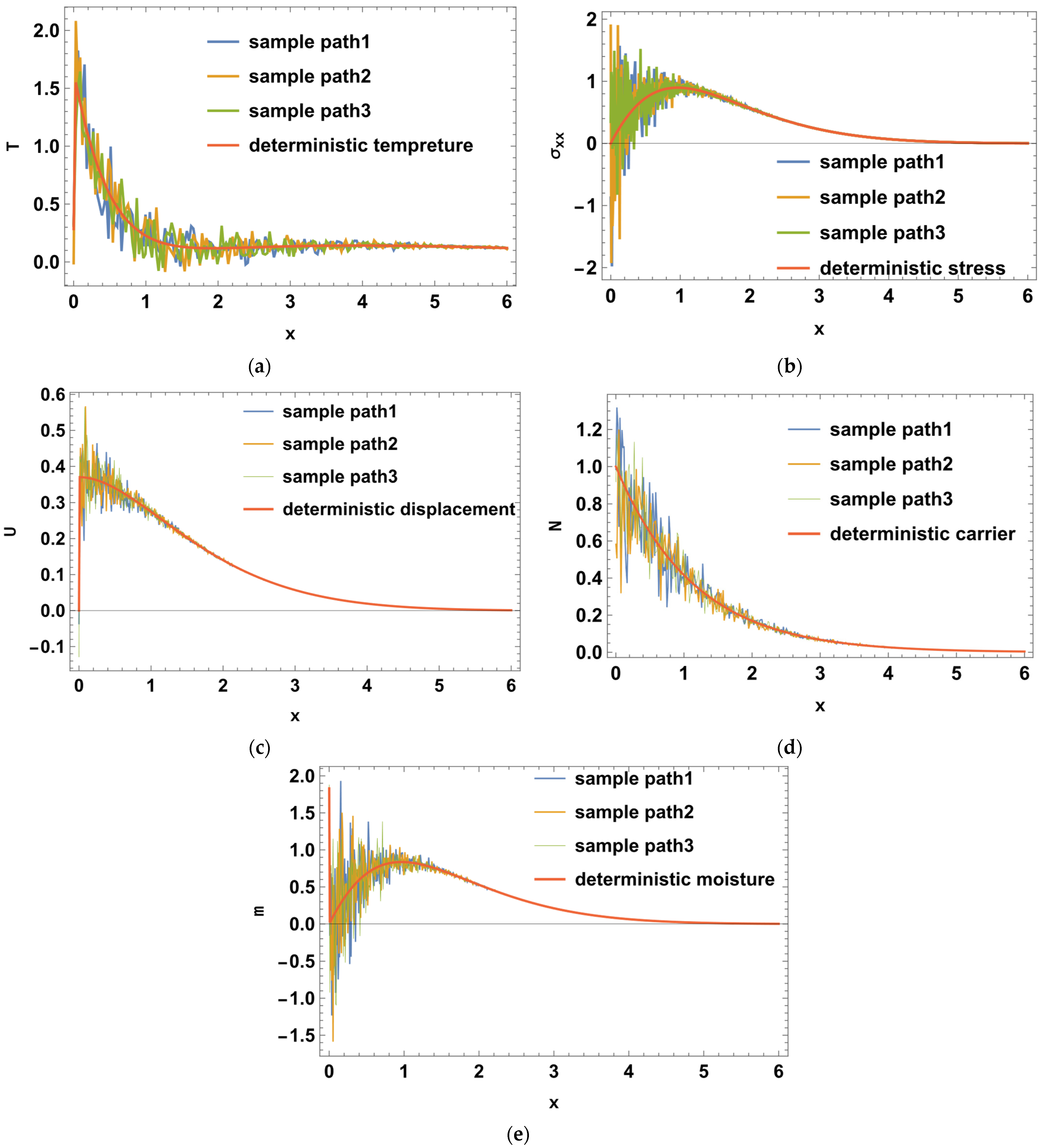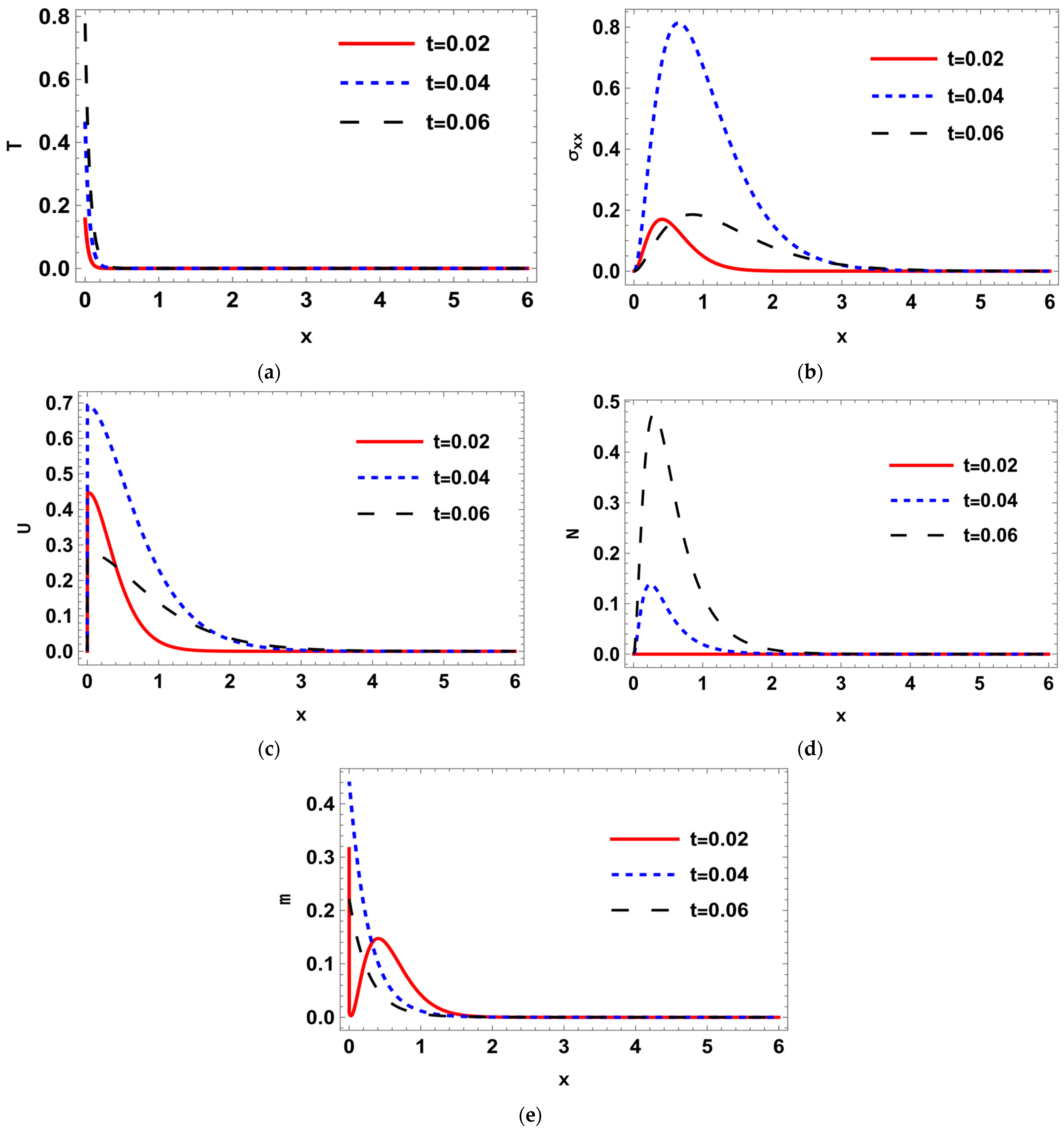Moisture Photo-Thermoelasticity Diffusivity in Semiconductor Materials: A Novel Stochastic Model
Abstract
:1. Introduction
2. Basic Equations
3. Mathematical Formulation of the Problem
4. The Solution of the Problem
5. Boundary Conditions
6. Inversion of the Fourier-Laplace Transforms
7. Stochastic Main Physical Fields
7.1. Stochastic of Temperature (Thermal Wave)
7.2. Deterministic Stress Distribution
7.3. Stochastic Stress Distribution
7.4. Deterministic Displacement Distribution
7.5. Stochastic Displacement Distribution
7.6. Deterministic Carrier Density Distribution
7.7. Stochastic Carrier Density Distribution
7.8. Deterministic Moisture Concentration Distribution
7.9. Stochastic Moisture Concentration Distribution
8. Numerical Results and Discussions
9. Conclusions
Author Contributions
Funding
Data Availability Statement
Acknowledgments
Conflicts of Interest
Appendix A
References
- Biot, M. Thermoelasticity and irreversible thermodynamics. J. Appl. Phys. 1956, 27, 240–253. [Google Scholar] [CrossRef]
- Lord, H.; Shulman, Y. A generalized dynamical theory of thermoelasticity. J. Mech. Phys. Solids 1967, 15, 299–309. [Google Scholar] [CrossRef]
- Green, A.; Lindsay, K. Thermoelasticity. J. Elast. 1972, 2, 1–7. [Google Scholar] [CrossRef]
- Lebon, D.J.G.; Casas-Vzquez, J. Understanding Non-Equilibrium Thermodynamics: Foundations, Applications, Frontiers; Springer: Berlin/Heidelberg, Germany, 2008. [Google Scholar]
- Maurer, M.J.; Thompson, H.A. Non-fourier effects at high heat flux. J. Heat Transf. 1973, 95, 284–286. [Google Scholar] [CrossRef]
- Sherief, H.H.; Dhliwal, R.S. Generalized one-dimensional thermal-shock problem for small times. J. Therm. Stress. 1981, 4, 407–420. [Google Scholar] [CrossRef]
- Marin, M. Harmonic vibrations in thermoelasticity of microstretch materials, journal of vibration and acoustics. Trans. ASME 2010, 132, 044501. [Google Scholar]
- Marin, M.; Othman, M.; Abbas, I. An extension of the domain of influence theorem for generalized thermoelasticity of anisotropic material with voids. J. Comp. Theor. Nanosci. 2015, 12, 1594–1598. [Google Scholar] [CrossRef]
- Othman, M.; Lotfy, K. On the plane waves of generalized thermo-microstretch elastic half-space under three theories. Int. Comm. Heat Mass Trans. 2010, 37, 192–200. [Google Scholar] [CrossRef]
- Abouelregal, A.; Marin, M. The Size-Dependent Thermoelastic Vibrations of Nanobeams Subjected to Harmonic Excitation and Rectified Sine Wave Heating. Mathematics 2020, 8, 1128. [Google Scholar] [CrossRef]
- Othman, M.; Lotfy, K. Effect of rotating on plane waves in generalized thermo-microstretch elastic solid with one relaxation time, Multidis. Model. Mat. Struct. 2011, 7, 43–62. [Google Scholar] [CrossRef]
- Ailawalia, P.; Sachdeva, S.; Pathania, D. Plane strain deformation in a thermo-elastic microelongated solid with internal heat source. Int. J. Appl. Mech. Eng. 2015, 20, 717–731. [Google Scholar] [CrossRef]
- Todorovic, D.; Nikolic, P.; Bojic, A. Photoacoustic frequency transmission technique: Electronic deformation mechanism in semiconductors. J. Appl. Phys. 1999, 85, 7716–7726. [Google Scholar] [CrossRef]
- Todorovic, D. Plasma, thermal, and elastic waves in semiconductors. Rev. Sci. Instrum. 2003, 74, 582–591. [Google Scholar] [CrossRef]
- Gordon, J.P.; Leite, R.C.C.; Moore, R.S.; Porto, S.P.S.; Whinnery, J.R. Long-transient effects in lasers with inserted liquid samples. Bull. Am. Phys. Soc. 1964, 119, 501–510. [Google Scholar] [CrossRef]
- Kreuzer, L.B. Ultralow gas concentration infrared absorption spectroscopy. J. Appl. Phys. 1971, 42, 2934. [Google Scholar] [CrossRef]
- Tam, A.C. Ultrasensitive Laser Spectroscopy; Academic Press: New York, NY, USA, 1983; pp. 1–108. [Google Scholar]
- Tam, A.C. Applications of photoacoustic sensing techniques. Rev. Mod. Phys. 1986, 58, 381. [Google Scholar] [CrossRef]
- Hobiny, A.; Abbas, I. A GN model on photothermal interactions in a two-dimensions semiconductor half space. Results Phys. 2019, 15, 102588. [Google Scholar] [CrossRef]
- Lotfy, K. A Novel Model of Photothermal Diffusion (PTD) for Polymer Nano- composite Semiconducting of Thin Circular Plate. Phys. B-Condenced Matter 2018, 537, 320–328. [Google Scholar] [CrossRef]
- Lotfy, K.; Kumar, R.; Hassan, W.; Gabr, M. Thermomagnetic effect with microtemperature in a semiconducting Photothermal excitation medium. Appl. Math. Mech. Engl. Ed. 2018, 39, 783–796. [Google Scholar] [CrossRef]
- Lotfy, K. A novel model for Photothermal excitation of variable thermal conductivity semiconductor elastic medium subjected to mechanical ramp type with two-temperature theory and magnetic field. Sci. Rep. 2019, 9, 3319. [Google Scholar] [CrossRef]
- Abbas, I.; Alzahranib, F.; Elaiwb, A. A DPL model of photothermal interaction in a semiconductor material, Waves Rand. Comp. Media 2019, 29, 328–343. [Google Scholar]
- Khamis, A.; El-Bary, A.; Lotfy, K.; Bakali, A. Photothermal excitation processes with refined multi dual phase-lags theory for semiconductor elastic medium. Alex. Eng. J. 2020, 59, 1–9. [Google Scholar] [CrossRef]
- Lotfy, K.; El-Bary, A.; El-Sharif, A. Ramp-type heating micro-temperature for a rotator semiconducting material during photo-excited processes with magnetic field. Results Phys. 2020, 19, 103338. [Google Scholar] [CrossRef]
- Lotfy, K.; Tantawi, R.; Anwer, N. Response of Semiconductor Medium of Variable Thermal Conductivity Due to Laser Pulses with Two-Temperature through Photothermal Process. Silicon 2019, 11, 2719–2730. [Google Scholar] [CrossRef]
- Szekeres, A. Analogy Between Heat and Moisture Thermohygro-mechanical Tailoring of Composites by Taking into Account the Second Sound Phenomenon. Comput. Struct. 2000, 76, 145–152. [Google Scholar] [CrossRef]
- Szekeres, A. Cross-coupled Heat and Moisture Transport: Part 1 Theory. J. Therm. Stress. 2012, 35, 248–268. [Google Scholar] [CrossRef]
- Gasch, T.; Malm, R.; Ansell, A. Coupled hygro-thermomechanical model for concrete subjected to variable environmental conditions. Int. J. Solids Struct. 2016, 91, 143–156. [Google Scholar] [CrossRef]
- Szekeres, A.; Engelbrecht, J. Coupling of Generalized Heat and Moisture Transfer. Period. Polytech. Ser. Mech. Eng. 2000, 44, 161–170. [Google Scholar]
- Jarrow, R.; Protter, P. A short history of stochastic integration and mathematical finance: The early years, 1880–1970. Inst. Math. Stat. Lect. Notes—Monogr. Ser. 2004, 45, 75–91. [Google Scholar]
- Brush, S. A history of random processes. Arch. Ration. Mech. 1968, 5, 1–36. [Google Scholar] [CrossRef]
- Meyer, P. Stochastic Processes from 1950 to the Present. Electron. J. Hist. Probab. Stat. 2009, 5, 1–42. [Google Scholar]
- Richard, S. An overview of the theory of large deviations and applications to statistical mechanics. Scand. Actuar. J. 1995, 1, 97–142. [Google Scholar]
- Lotfy, K.; Ahmed, A.; El-Bary, A.; El-Shekhipy, A.; Tantawi, R.S. A novel stochastic photo-thermoelasticity model according to a diffusion interaction processes of excited semiconductor medium. Eur. Phys. J. Plus 2022, 137, 972. [Google Scholar] [CrossRef] [PubMed]
- Hosseini, S.; Sladek, J.; Sladek, V. Application of meshless local integral equations to two-dimensional analysis of coupled non-Fick diffusion elasticity. Eng. Anal. Bound. Elem. 2013, 37, 603–615. [Google Scholar] [CrossRef]
- Abo-Dahab, S.; Lotfy, K. Two-temperature plane strain problem in a semiconducting medium under photothermal theory. Waves Random Complex Media 2017, 27, 67–91. [Google Scholar] [CrossRef]
- Lotfy, K.; Sarkar, N. Memory-dependent derivatives for photothermal semiconducting medium in generalized thermoelasticity with two-temperature. Mech. Time-Depend. Mater. 2017, 21, 519–534. [Google Scholar] [CrossRef]
- Lotfy, K.; Elidy, E.; Tantawi, R. Photothermal excitation process during hyperbolic two-temperature theory for magneto-thermo-elastic semiconducting medium. Silicon 2021, 13, 2275–2288. [Google Scholar] [CrossRef]
- Lotfy, K.; Hassan, W.; Gabr, M. Thermomagnetic effect with two temperature theory for photothermal process under hydrostatic initial stress. Results Phys. 2017, 7, 3918–3927. [Google Scholar] [CrossRef]
- Lotfy, K.; Elidy, E.; Tantawi, R. Piezo-photo-thermoelasticity transport process for hyperbolic two-temperature theory of semiconductor material. Int. J. Mod. Phys. C 2021, 32, 2150088. [Google Scholar] [CrossRef]
- Honig, G.; Hirdes, U. A method for the numerical inversion of Laplace Transforms. Comp. Appl. Math. 1984, 10, 113–132. [Google Scholar] [CrossRef] [Green Version]
- Allam, A.; Ramadan, K.; Omar, M. A stochastic thermoelastic diffusion interaction in an infinitely long annular cylinder. Acta Mech. 2016, 227, 1429–1443. [Google Scholar] [CrossRef]
- Gupta, M.; Mukhopadhyay, S. Stochastic thermoelastic interaction under a dual phase-lag model due to random temperature distribution at the boundary of a half-space. Math. Mech. Solids 2019, 24, 1873–1892. [Google Scholar] [CrossRef]
- Hingham, D.J. An algorithmic introduction to numerical simulation of stochastic differential equations. Soc. Ind. Appl. Math. SIAM Rev. 2001, 43, 525–546. [Google Scholar]
- Abbas, I. A GN model for thermoelastic interaction in an unbounded fiber-reinforced anisotropic medium with a circular hole. Appl. Math. Lett. 2013, 26, 232–239. [Google Scholar] [CrossRef] [Green Version]
- Abbas, I. Eigenvalue approach on fractional order theory of thermoelastic diffusion problem for an infinite elastic medium with a spherical cavity. Appl. Math. Model. 2015, 39, 6196–6206. [Google Scholar] [CrossRef]
- Abbas, I.; Abdalla, A.; Alzahrani, F.; Spagnuolo, M. Wave propagation in a generalized thermoelastic plate using eigenvalue approach. J. Therm. Stress. 2016, 39, 1367–1377. [Google Scholar] [CrossRef]
- Abbas, I. Analytical solution for a free vibration of a thermoelastic hollow sphere. Mech. Based Des. Struct. Mach. 2015, 43, 265–276. [Google Scholar] [CrossRef]
- Abbas, I. A two-dimensional problem for a fibre-reinforced anisotropic thermoelastic half-space with energy dissipation. Sadhana 2011, 36, 411–423. [Google Scholar] [CrossRef] [Green Version]
- Sherief, H.H. A thermo-mechanical shock problem for thermoelasticity with two relaxation times. Int. J. Eng. Sci. 1994, 32, 313–325. [Google Scholar] [CrossRef]



| Units | Symbol | Si |
|---|---|---|
| , | ||
| - | ||
| - | ||
Disclaimer/Publisher’s Note: The statements, opinions and data contained in all publications are solely those of the individual author(s) and contributor(s) and not of MDPI and/or the editor(s). MDPI and/or the editor(s) disclaim responsibility for any injury to people or property resulting from any ideas, methods, instructions or products referred to in the content. |
© 2022 by the authors. Licensee MDPI, Basel, Switzerland. This article is an open access article distributed under the terms and conditions of the Creative Commons Attribution (CC BY) license (https://creativecommons.org/licenses/by/4.0/).
Share and Cite
Alenazi, A.; Ahmed, A.; El-Bary, A.A.; Tantawi, R.S.; Lotfy, K. Moisture Photo-Thermoelasticity Diffusivity in Semiconductor Materials: A Novel Stochastic Model. Crystals 2023, 13, 42. https://doi.org/10.3390/cryst13010042
Alenazi A, Ahmed A, El-Bary AA, Tantawi RS, Lotfy K. Moisture Photo-Thermoelasticity Diffusivity in Semiconductor Materials: A Novel Stochastic Model. Crystals. 2023; 13(1):42. https://doi.org/10.3390/cryst13010042
Chicago/Turabian StyleAlenazi, Abdulaziz, Abdelaala Ahmed, Alaa A. El-Bary, Ramdan S. Tantawi, and Khaled Lotfy. 2023. "Moisture Photo-Thermoelasticity Diffusivity in Semiconductor Materials: A Novel Stochastic Model" Crystals 13, no. 1: 42. https://doi.org/10.3390/cryst13010042
APA StyleAlenazi, A., Ahmed, A., El-Bary, A. A., Tantawi, R. S., & Lotfy, K. (2023). Moisture Photo-Thermoelasticity Diffusivity in Semiconductor Materials: A Novel Stochastic Model. Crystals, 13(1), 42. https://doi.org/10.3390/cryst13010042








